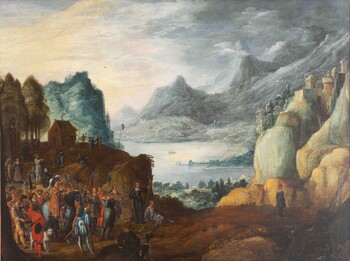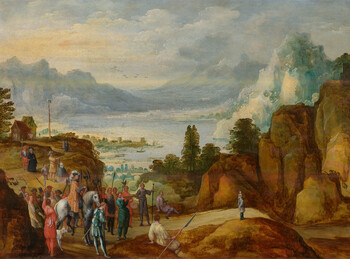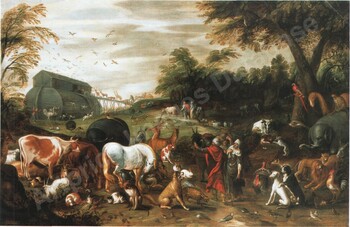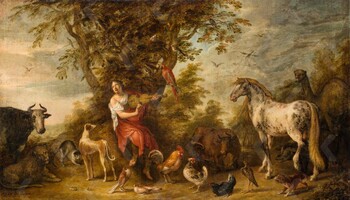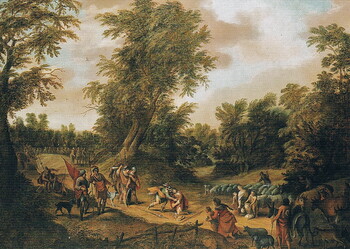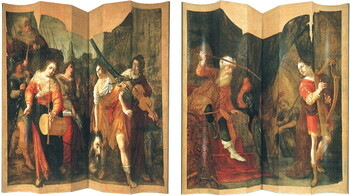9.200 €
The legend of William Tell
Oil on canvas : 52,6 X 83,2 cm
Unsigned; circa 1625/1630
Frame : 72,3 X 102,5 cm
Published by Jan Briels in “Vlaamse schilders in de Noordelijke Nederlanden in het begin van de Gouden Eeuw”, 1987, P. 69, Pl. 60
Published by Eric Jan Sluijter in “Rembrandt’s rivals”, 2015, Fig. IV-5
Provenance : before 1987 with Gallery Jan De Maere, Brussels
In short
At the start of the 14th century the successful apple shot with a crossbow by the local hero William Tell initiated the Swiss revolt in the canton of Uri against the Austrian oppressor.
At the start of the 14th century the successful apple shot with a crossbow by the local hero William Tell initiated the Swiss revolt in the canton of Uri against the Austrian oppressor.
I know of only three Flemish or Dutch 17th century paintings representing this rare theme of William Tell shooting an arrow at an apple on his son’s head: two by Joos de Momper II and our painting. In all three versions the boy has turned his back to his father.
David Colijns was born in Rotterdam but he spent his complete career in the Dutch metropolis of Amsterdam. Many 17th century painters used different spellings for their proper name. Colijns used “Colijns”, “Colyns”, “Colijn” and “Celijns”.
About David Colijns
Dutch painter
Rotterdam circa 1582 – 1664/1666 Amsterdam
Painter of landscapes, genre, history and church interior scenes. Best known for his biblical scenes.
It is not known whom Colijns studied under, but it must probably have been his father, Crispiaen Colijns, who was also a painter. David’s father originally came from Mechelen in Flanders. Being a Protestant he had fled to Rotterdam in Holland the persecution by the Spanish of Flemish Catholics.
The famous history and portrait painter Salomon Koninck (1609 – 1656) was a pupil of our David Colijns, as was Jacob I Koninck (1614/16 – after 1690), a lesser-known painter of landscapes and of portraits.
Colijns is documented as being active in Amsterdam from 1606 until his death around 1665. He held several functions in the local Painter’s Guild.
Already in 1607 Colijns was one of the buyers inscribed at the sale of paintings in Amsterdam of the late Gillis van Coninxloo II, the famous painter of wooded landscapes.
Colijns married in Amsterdam in 1613.
Around 1635/1640 he painted the monumental scenes from the life of King David that served as shutters for the organ of the Nieuwezijdse Chapel of Amsterdam. Today they have a prominent place in the Catharijneconvent Museum of Utrecht.
Colijns was also active as staffage painter; he painted the figures in landscapes by Gillis de Hondecoeter, Govaert and Jochem Camphuysen.
About the subject of our painting, William Tell
Set in 1307, at the start of the 14th century, the legend of the Swiss folk hero William Tell, the rebel who fought against tyranny, can be considered the founding point of the Swiss Confederacy.
In those days the Austrian House of Habsburg tried to impose itself in the Swiss Canton of Uri. In its capital, the small town of Altdorf, the Austrian Landvogt Albrecht Gessler had hung his hat on top of a pole. He obliged the locals to bow before it. William Tell walked past it with his son, Walter, but both refused to bow, so they were arrested. Baron Gessler had heard that William was an expert shot with his crossbow. If William could shoot with a single shot an apple from his son’s head, both would not be executed. William succeeded, but then Gessler saw he held a second arrow (a bolt). William told him that had he missed he would have killed the Landvogt with it. Gessler was enraged and decided to imprison William Tell for the remainder of his life. During a storm on Lake Lucerne Tell escaped from the boat, fled over land and finally killed Gessler with that second bolt. William Tell’s courageous behaviour triggered the local Swiss Revolt against the Austrians.
William Tell became a popular hero in Switzerland during the 16th century. The Antwerp painter Joos de Momper II (1564 – 1635), painted twice the apple shot. He must have picked up this legend during his journey to Italy in the 1680s. But it remains a mystery why our David Colijns, a Dutchman who never travelled thru Switzerland, also painted it.
It is remarkable that in these three paintings the boy turns his back to his father.
In the early 19th century Tell’s popularity rose to new heights thanks to Friedrich von Schiller’s play of 1803/04 and to Gioachino Rossini’s opera (with the famous Ouverture) of 1829.
Why should you buy this painting?
Because this iconic theme is such a rare subject in 17th century painting.
Comparative paintings
Click photos for more details

